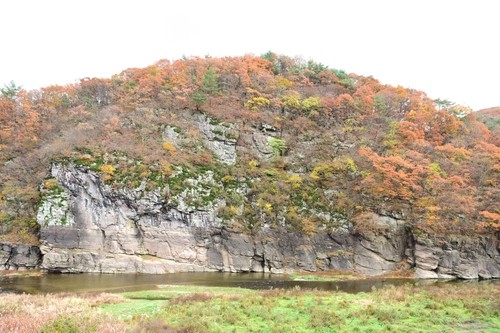(ATTN: ADDS details in paras 9-16)
SEOUL, May 26 (Yonhap) — A set of prehistoric petroglyphs located in southeastern South Korea is likely to be listed as a UNESCO World Heritage site, people familiar with the matter said Monday.
The International Council on Monuments and Sites (ICOMOS), an advisory body to UNESCO, has recommended the inclusion of the Petroglyphs along the Bangucheon Stream on the UNESCO World Heritage list, following its review of the nomination, they said.
A recommendation by ICOMOS is deemed a preliminary approval for UNESCO World Heritage status. The final decision will be made at the upcoming World Heritage Committee meeting in Paris in July.
This file photo, provided by the Korea Heritage Service, shows the Bangudae petroglyphs in the county of Ulju, in Ulsan, about 300 kilometers southeast of Seoul. (PHOTO NOT FOR SALE) (Yonhap)
The engravings on the rock face of Bangudae, located on the lower part of a cliff on a tributary of a river in Ulsan, were first discovered in 1971 and were designated as the country’s National Treasure No. 285.
Bangudae was listed on the UNESCO World Heritage Tentative List in 2011. South Korea applied for the UNESCO listing of the petroglyphs, located in Ulsan, in January last year.
If registered, the petroglyphs will become South Korea’s 17th UNESCO World Heritage site.
The petroglyphs site is a single property that includes the Petroglyphs of Bangudae Terrace — a National Treasure — with a high concentration of engraved images, as well as the Petroglyphs of Cheonjeon-ri.
The engraved images include numerous humans, animals, ships, tools and nets. Experts say the petroglyphs are presumed to have been made some time between the late Neolithic period and the Bronze Age.
Located on a cliff along the Bangu Stream, the Bangudae petroglyphs are engraved on a rock face measuring about 4.5 meters in height and 8 meters in width. The carvings show marine and terrestrial animals and hunting scenes.
The Bangudae petroglyphs are well known for featuring the world’s oldest known depiction of whale hunting.
A 2023 report by the Ulsan metropolitan city shows that 312 individual engravings were identified from the Bangudae petroglyphs when analyzed through three-dimensional scanning.
The Cheonjeon-ri petroglyphs are located about 2 kilometers from the Bangudae site. It was discovered in 1970, containing over 620 figures, symbols and drawings engraved along a rock surface — about 2.7 meters high and 9.8 meters wide.

This file photo, provided by the Korea Heritage Service, shows the Bangudae petroglyphs site in the county of Ulju, in Ulsan, about 300 kilometers southeast of Seoul. (PHOTO NOT FOR SALE) (Yonhap)
The petroglyphs, however, have posed challenges because they are frequently submerged due to changes in the water level of Sayeon Dam located nearby. The dam was constructed in 1965, before the images were discovered.
Over the past decade, the petroglyphs have been under water for an average of 42 days per year.
Discussions have been underway at the government and expert levels for preservation efforts, including adjusting the dam’s water level and building temporary embankments.
Currently, plans are under way to install floodgates at Sayeon Dam’s spillway to lower water levels and protect the site.
elly@yna.co.kr
(END)
